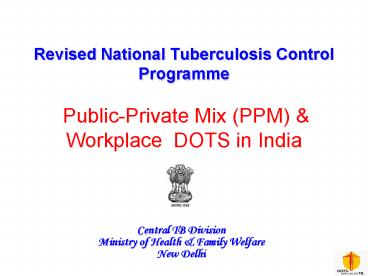Revised National Tuberculosis Control Programme PublicPrivate Mix PPM - PowerPoint PPT Presentation
1 / 29
Title:
Revised National Tuberculosis Control Programme PublicPrivate Mix PPM
Description:
Scheme 4- Microscopy & Treatment centre. Scheme 5- TB unit model ... Establish Microscopy cum DOT centre. Identify Medical Officer, Lab Technician and DOT provider ... – PowerPoint PPT presentation
Number of Views:719
Avg rating:3.0/5.0
Title: Revised National Tuberculosis Control Programme PublicPrivate Mix PPM
1
Revised National Tuberculosis Control Programme
Public-Private Mix (PPM) Workplace DOTS in
India
- Central TB DivisionMinistry of Health Family
WelfareNew Delhi
2
RNTCP Major milestones in PPM DOTS
3
Tools for PPM DOTS
4
RNTCP guidelines for the involvement of NGOs
(2001)
5
Involvement of NGOs in RNTCP
- There are 5 Schemes for collaboration with NGOs
- Scheme 1- Health education community
outreach - Scheme 2- Provision of DOT
- Scheme 3- In-hospital care for TB disease
- Scheme 4- Microscopy Treatment centre
- Scheme 5- TB unit model
6
RNTCP guidelines for the involvement of private
practitioners (2002)
7
PP schemes
- 1. Referral services
- 2. Provision of Directly Observed Therapy
- 3a. Designated Paid MC microscopy only.
- 3b. Designated Paid MC microscopy and
treatment. - 4a. Designated MC microscopy only.
- 4b. Designated MC microscopy and treatment.
8
RNTCP PPM DOTS advocacy kit (2005)
9
Training module for private medical
practitioners
- Concise module
- 6 hours training
- 1 day X 6 hours
- 2 days X 3 hours
- 3 days X 2 hours
10
Progress in 2007
- 17283 private practitioners involved
- 2482 NGOs involved
- About 250 medical colleges involved
- gt150 corporate houses involved
- GFATM IMA project launched in six states
- Launching of IMPACT (Indian Medical Professional
Association Coalition against TB)
11
Intensified PPM project in urban areas
- Objective To increase the proportion of TB
cases being diagnosed and treated under DOTS
strategy through systematic involvement of all
types of health care providers and documentation
of the processes and outcomes - Started in 14 districts (urban) in 4 qtr 2003
- Later scaled-up to 70 districts (15 states and 1
UT) - Currently being scaled-up to the entire country
- Modified surveillance system implemented in the
14 districts to measure contributions from
different types of providers
12
(No Transcript)
13
GFATM Urban DOT Projects
14
GFATM Urban DOTS Projects
- Based on PPM approach and targeting mainly the
urban poor (urban slums) - REACH project in Chennai funded under GFATM R-1
- Urban DOTS project in 4 cities funded under GFATM
R-2 - Inter-Aide Mumbai
- Social Welfare Institute Varanasi
- Bhagwan Mahavir Medical Research Centre Hyderabad
- MP Voluntary Health Association (MPVHA) Indore
- IMA Project in five states and one UT under GFATM
Round 6 launched in October 2007
15
Results of Urban DOTS Projects
- Established baseline data on health providers and
slum populations - Improved patients adherence to treatment through
DOT( Reduced default rate) - Improved quality of private sector laboratory
services by inclusion under RNTCP EQA system - 6867 PPs/ 1769 PPM centres established
- On an average contributed 15-20 in case
detection in the respective districts
16
Workplace DOTS
17
Benefits of Workplace DOTS
- Employer Benefits
- -Decreased absenteeism
- -Increased productivity
- - Increased morale at workplace
- Employee/Family Benefits
- - No loss of wages
- - No loss of workdays
- Community/Nation Benefits
- - Reduction in prevalence of TB
- - Reduction in morbidity and mortality of TB
- - Reduction in transmission of the infection
- Workplace DOTS is a WIN-WIN situation
18
Involvement of workplace DOTS - examples
- Coal India - Burdwan (TU), Nagpur Ranchi (MC)
- Tea Industry - Jalpaiguri,Idukki,Nilgiris(MC)
- Steel/aluminium Plant - Hindalco, Rourkela,
Bhillai, Keonjar(MC ) - Cement Factory - Sundergarh ,Katni, Raipur( MC )
- NTPC - Gautam Budh Nagar(MC)
- Jute mills - Howrah(TC)
- Mines - Keonjhar
- Sugar mills - Ghaziabad,Muzzarfarnagar,Daurala(TC)
- Petro-chemicals Industries Reliance in Surat
(MC)
19
Roles Industries play (contd.)
20
RNTCP will
- Provide technical expertise and training
- Provide lab consumables, registers and patient
cards for recording - Provide free drugs in Patient wise boxes
- Monitor and report results on a monthly basis
- Share results on RNTCP web site
- Provide awareness material templates/ prototypes
21
Challenges
- Huge private sector but proportionately less
involvement of private providers - Reluctance of Private and NGO sectors to sign
formal agreements with government - Getting private sector to agree to be supervised
and quality assured by Government staff - Mutual recognition, continuing dialogue and
sharing of responsibilities is a key to success
22
Future plans
- Dissemination of PPM training/sensitization tools
- Standardized approach tools to enhance access
to DOT services in Urban slums - Revision of the NGO/PP schemes
- Collaboration with CBCI
- - monitoring its health facilities for RNTCP
implementation - - documenting its contribution
23
Thanks
- www.tbcindia.org
24
Reliance TB Control Centre, SURAT, Gujarat
25
BHEL ,Bhopal , MP
26
TEA estates ,Dibrugarh, Assam
27
(No Transcript)
28
Tea Garden, Jalpaiguri, West Bengal
29
(No Transcript)

